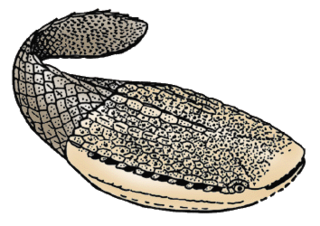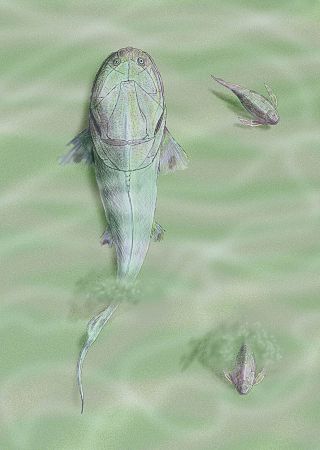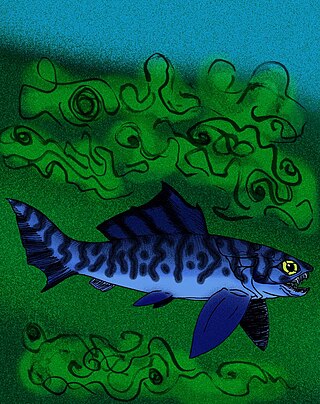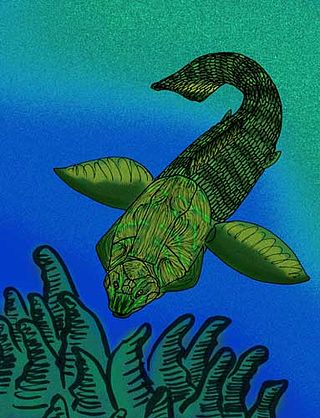
Protaspididae is an extinct family of pteraspidid heterostracan agnathans. Fossils of the various genera are found in early Devonian-aged marine strata. Protaspidids were once thought to represent a transitional form between the Pteraspididae and the Psammosteida, bearing the broad head shield shape of the latter, due to a more benthic (bottom-dwelling) existence, but recent phylogenical comparisons demonstrate that the protaspidids are actually highly derived pteraspidids, and that the anchipteraspidids, the most primitive of pteraspidids, are the sister-group of the Psammosteids.

Astraspida, or astraspids, are a small group of extinct armored jawless vertebrates, which lived in the Middle Ordovician in North America. They are placed among the Pteraspidomorphi because of the large dorsal and ventral shield of their head armor. They are represented by a single genus, Astraspis, including possibly two species, A. desiderata and A. splendens but their remains are fairly abundant in Ordovician sandstones of the USA and Canada (Quebec). The head armor of Astraspis is rather massive, with a series of ten gill openings lining the margin of the dorsal shield, and laterally placed eyes. The dorsal shield is ribbed by strong longitudinal crests, and the tail is covered with large, diamond-shaped scales. They are often grouped together with the Arandaspidida.

Weejasperaspididae is a family of three extinct acanthothoracid placoderms indigenous to the Early Devonian of Victoria and New South Wales, Australia.

Homosteus is a genus of flattened arthrodire placoderm from the Middle Devonian. Fossils are found primarily in Eifelian-epoch aged strata of Europe, Canada, Greenland, and Estonia. All of the species had comparatively large, flattened heads with, as suggested by the upward opening orbits, upward-pointing eyes. These adaptations suggest that the various species were benthic predators. A study on Titanichthys, in contrast, suggests that species of Homosteus may have been filter-feeders instead.

Holonema is an extinct genus of relatively large, barrel-shaped arthrodire placoderms that were found in oceans throughout the world from the Mid to Late Devonian, when the last species perished in the Frasnian-Fammian extinction event. Most species of the genus are known from fragments of their armor, but the Gogo Reef species, H. westolli, is known from whole, articulated specimens.

Selenosteus brevis is an extinct large selenosteid arthrodire placoderm known from the Famennian Cleveland Shale of Ohio. Scrappy remains from the Frasnian Rhinestreet Shales of Erie County, New York, were attributed by Hussakof and Bryant to this genus in 1919, but, this identification is doubtful. A second species, S. kepleri, was described in 1901, but, not enough differences can be seen between its specimens, and those of the type species to warrant new species status.

Hadrosteus is an extinct monospecific genus of large arthrodire placoderm from the Late Frasnian Kellwasserkalk facies of Bad Wildungen, Germany. It had large, double-pronged inferognathals, and serrated edges along its mandible, strongly suggesting that it was a fish-eating predator. The head had a triangular snout, and the trunkshield was short, but high, with a median dorsal plate that was broader than wide. The average skull length is about 16 centimeters.

Pachyosteus is an extinct monospecific genus of medium-sized selenosteid arthrodire placoderm known from the Upper Frasnian Kellwasserkalk facies of Late Devonian Bad Wildungen, Germany and from the Famennian portions of the Holy Cross Mountains of Poland. The type species Pachyosteus bulla has a broad skull about 7 to 10 centimetres long, a comparatively long median dorsal plate, and a short rostral plate that meets the pineal plate.

Holonematidae is an extinct family of relatively large arthrodire placoderms from the Early to Late Devonian. Almost all fossil specimens are of armor fragments, though, all have distinctive ornamentation, often of unique arrangements and patterns of tubercles, that are diagnostic of the family. The trunkshield is very elongated, giving the armor an overall "barrel" like appearance.

Belemnacanthus giganteus is a large, extinct, barrel-shaped holonematid arthrodire placoderm from Givetian-aged strata of Middle Devonian Eifel, Germany. B. giganteus is known only from the holotype, a 37 centimetres (15 in) portion of a median dorsal plate with a long, somewhat high, arching crest running down the median line of the exterior/dorsal side of the plate. The plate has an ornamentation of ridges that originate from a point posterior to the preserved portion of the median dorsal plate. Before the plate was identified as that of a holonematid, the plate of B. giganteus had been successively described as a tremendous spine of an elasmobranch, an agnathan, and lastly, the plate of an antiarch.

Rhenonema eifeliense is a large, extinct, high-crested holonematid arthrodire placoderm from Givetian-aged strata of Middle Devonian Gerolstein, Germany. It is known from some fragments of armor, including an anterior-lateral plate estimated to be around 24 centimetres (9.4 in) long, and a portion of a median dorsal plate with a very tall crest running along the median line of the dorsal surface. The ornamentation is very similar to that of Holonema, but the concentrically arranged ridges are much coarser in Rhenonema. The holotype was originally described by Kayser, in 1880, as a species of Dinichthys, but was then redescribed in 1964 by Obruchev as a holonematid.

Homostiidae is a family of flattened arthrodire placoderms from the Early to Middle Devonian. Fossils appear in various strata in Europe, Russia, Morocco, Australia, Canada and Greenland.

Aspidichthys is a genus of large, distinctively tuberculated arthrodire placoderm of uncertain affinities from Upper Devonian marine strata in the Eastern United States and Europe.

Brachydeiridae is a family of small to moderately large-sized arthrodire placoderms from the Late Devonian of Europe, restricted primarily to the Kellwasserkalk Fauna of Bad Wildungen and Adorf.

Brachydeirus is a genus of small to moderately large-sized arthrodire placoderms from the Late Devonian of Europe, restricted to the Kellwasserkalk Fauna of Bad Wildungen and Adorf.

Oxyosteus is a genus of trout-sized, highly compressed arthrodire placoderms from the Late Devonian of Europe: The two described species are restricted to the Late Frasnian-aged Kellwasserkalk Fauna of Bad Wildungen, while a median dorsal plate of an unnamed species is known from the Middle Frasnian Holy Cross Mountains of Poland.
Microbrachius is an extinct genus of tiny, advanced antiarch placoderms closely related to the bothriolepids. Specimens range in age from the Lower Devonian Late Emsian Stage to the Middle Devonian Upper Givetian Stage. They are characterized by having large heads with short thoracic armor of an average length of 2-4 cm. There are patterns of small, but noticeable tubercles on the armor, with the arrangement varying from species to species. Specimens of Microbrachius have been found in Scotland, Belarus, Estonia, and China.

Traquairaspidiformes is an order of extinct heterostracan agnathan fish known from the Silurian and Early Devonian periods. Fossils are predominantly known from Late Silurian fluvial deposits from Wales and England: some species were also found in strata representing shallow water marine environment in Canada and North America.

Zenaspidida is an extinct order of osteostracans, a group of jawless stem-gnathostomes. They possessed a distinct headshield, which varied in width to length ratio by species.

Asterolepis is an extinct genus of antiarch placoderms from the Devonian of North and South America and Europe. They were heavily armored flat-headed benthic detritivores with distinctive jointed limb-like pectoral fins and hollow spine. The armor plate gives the Asterolepis a box-like shape. Its pectoral fins are also armored but the caudal and dorsal fin are not. The first fossils were named by M. Eichwald in 1840 after noticing star-like markings on the fossils.

























